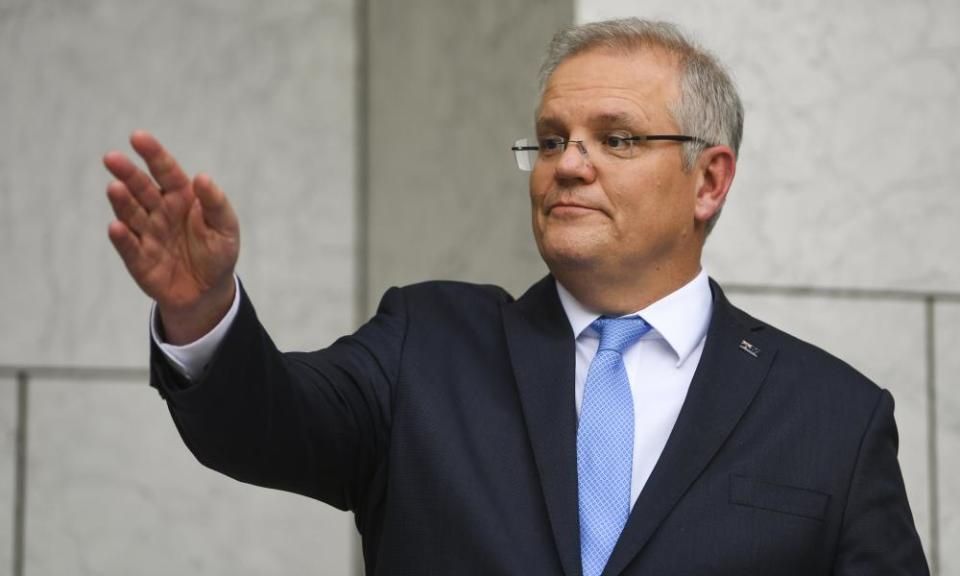Don’t be fooled by Morrison’s benevolence – soon it’s back to tax cuts and smaller government

This week the latest job vacancy figures were released, and as with so much economic data they were laughably out of date the moment they were published.
In the February quarter the number of job vacancies barely fell, but the number of unemployed in that time fell by a bit more. It meant the average number of unemployed per job vacancy across Australia dropped from 3.1 to 3 persons.
It’s ludicrous, of course.
Now the numbers are nowhere near that.
Just how bad they are is tough to estimate. Callam Pickering, economist at global job site Indeed, estimates that currently job adverts are running about 33% below what they were last year.
It would actually be surprising if they don’t drop by more – during the 1990s recession they fell by half.
Related: Morrison reminds us nothing lasts forever – especially the coronavirus spending spree | Malcolm Farr
At the same time, Westpac estimates that by June the unemployment rate will more than double to 11.1% .
Given the wage subsidies announced this week, which attempt to keep workers notionally employed, that figure might turn out to be overly pessimistic. But given as well the large numbers of casual workers who will miss out, being pessimistic is probably the right way to go.
If we assume unemployment doubles, and the number of vacancies halve, the number of unemployed per vacancy would rise in three months from three persons to 12. In some states such as South Australia it would shoot up to 19 unemployed per vacancy.
This would not actually be a record. During the 1990s recession, at one point across Australia there were 28 unemployed per vacancy and both Victoria and South Australia at various times had levels of 48 unemployed per vacancy.
But it certainly is a record increase – the speed with which coronavirus has changed the economy is beyond anything that has ever been experienced before.
And with it have come changes in what was previously considered impossible.
Doubling Newstart? Free childcare? A wage subsidy that is very close to a universal basic income? All previously dismissed as unaffordable or even “communist” are now government policy.
The temptation is to think this will mark a change in how things will be.
And sure, it would be nice if conservatives suddenly faced the reality that their “small government” narrative of the past 40 years has been reduced to ashes.
But even within the prime minister’s words we see that the policies, while sensible and essential, are not a signal of changed outlook.
The focus remains very much on businesses rather than workers, and Morrison’s own words betray that the underlying view point remains.
This week when announcing the childcare payments, he told reporters, “in this new normal that we’re living in, it’s no longer about entitlement. It’s about need.”
So subsidised childcare is only now about need? Wow.
He continued: “We’re calling on all Australians to think about what they need, and to think about the needs of their fellow Australians who may have a greater need when it comes to calling on the many things that are being provided.”
The lack of introspection about how there have always been many “fellow Australians who may have a greater need” is rather stunning.
Don’t be fooled into thinking we now have a socialist government. Right now Morrison likes to talk about the economy snapping back, and putting an end to this spending.
Related: Free childcare: what do the Australian government's coronavirus changes mean for my family?
Clearly the government wants to return to its mantra of tax cuts and smaller government.
Consider, the budget estimated the cost of flattening the income tax rate to 30% for those earning between $45,000 to $200,000 would cost $95bn in its first five years.
Given the current level of federal crisis spending totals $213.6bn, foregoing the tax cuts would, as John Quiggin has noted, essentially offset the spending in a mere 10 years.
But no, the tax cuts are sacrosanct – which means the debt will be paid with cuts that come as a result of lower revenue due to tax cuts and lower than anticipated economic growth.
Just as the GFC did nothing to change conservatives’ minds, and neither has climate change, don’t expect the coronavirus to bring about a Damascene conversion in favour of government services and assistance.
The only thing that will do that is if the public demands it – and votes for it.
• Greg Jericho writes on economics for Guardian Australia

